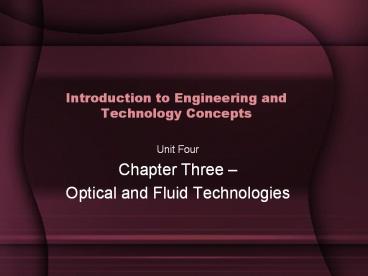Introduction to Engineering and Technology Concepts - PowerPoint PPT Presentation
1 / 15
Title:
Introduction to Engineering and Technology Concepts
Description:
Think about microscopes, lasers, fiber ... A typical fiber-optic cable has ... of Optics Optical Sensors Optics and Communication Fiber Optics ... – PowerPoint PPT presentation
Number of Views:137
Avg rating:3.0/5.0
Title: Introduction to Engineering and Technology Concepts
1
Introduction to Engineering and Technology
Concepts
- Unit Four
- Chapter Three
- Optical and Fluid Technologies
2
Instructions for Success
- Each chapter of every unit will begin with a
Mindjog. This is a warm up question that you
should answer in your workbook in the proper
chapter. - Please take notes as you move through the
presentations in the notebook that has been
provided. - Sections will come up in each presentation with
an assignment notice. Turn to the section
detailed on the slide in your workbook and
complete the assignment before proceeding. - Good luck!
3
Objective
- Students will define optical and fluid
technologies.
4
Mindjog!
- On your worksheet, please respond to the
following question - Could you imagine a trip to the grocery store
and having to manually punch in the bar code
numbers for each type of food item you purchase
instead of scanning it? What other types of
scanning devicesmake our lives easier?
5
Optical Technologies
- Optical Technologies consider the reaction to
visible light waves (Wright, 2004). - Optical properties include color (waves that are
reflected), optical transmission (ability to pass
light waves), and optical reflectivity (ability
to reflect light waves) (Wright, 2004). - Think about microscopes, lasers, fiber optics,
bar code readers, and scannershow do they play a
role in our lives (Wright, 2004)?
6
Concepts of Optics
- There are several important concepts to consider
when analyzing optical technology - Light Waves
- Frequency
- Period
- Reflection
- Refraction
- Diffraction
- Proportion
- Superposition
- Interference
- Doppler Effect
7
Optical Sensors
- Optical sensors can be used as a monitoring
device, in which levels of light or changes in
the intensity of light can be measured (Wright,
2004).
Photo Cell
Voltmeter
Light
(Wright, 2004)
8
Optics and Communication
- Weve been seeing how science and other subjects
relate to technology. - In truth, communication and optics have a lot to
do with each other. - Information has been transmitted with light for
many years. - One of the first kinds of methods used was smoke
signals. - More recently, flags and flashing lights have
been used to convey information (Wright, 2004).
9
Fiber Optics
- Still, the aforementioned techniques are limited
by the distance the information can be sent. - Fiber optics are channels that guide light waves
through internal reflection over some distance. - Internal reflection means that when the light
waves strike the outer edge of the fiber, they
are reflected back towards the center. - Optical communication of this type is called
guided optical transmission, which began
development in the 1960s (Wright, 2004).
10
Fiber Optics (continued)
- A typical fiber-optic cable has three layers.
- The outside layer is a protective plastic
coating. - The middle layer is called cladding, which
reflects light waves back into the glass fiber. - The inner layer is a strand of glass called the
core. The individual core strands are as small
as human hairs. - Several hundred of these strands are bundled
together into larger cables, with each of these
waveguides carrying numerous messages. - In fact, billions of bits of information per
second can move down an optical fiber. - Besides communication, fiber optics are finding
their way into the medical field in the endoscope
device, which can look inside the human
bodypossibly preventing unnecessary surgery
(Wright, 2004).
11
Fluid Power Systems
- Fluid Power Systems use either liquids or gases
to transfer power from one place to another
(Wright, 2004). - Systems that use air are called pneumatic
systems. - Liquids are used in hydraulic systems (Wright,
2004).
12
Assignment 1
- Please turn to the section in your workbook
entitled, Unit Five, Chapter Three Optical and
Fluid Technologies. - Complete the extension questions under the
Assignment 1 header before moving onto the
next section of slides.
13
BEFORE MOVING ON
- Did you complete the Assignment 1 Section
under the Unit Five, Chapter Three Optical and
Fluid Technologies section of your workbook? - If you have, please proceed to the next slide.
14
Chapter Three Completed!
- Please close this presentation and launch the
file entitled, Chapter 4 Electrical Energy.
15
References
- Wright, R. (2004) Technology The
Goodheart-Willcox Company, Inc.































